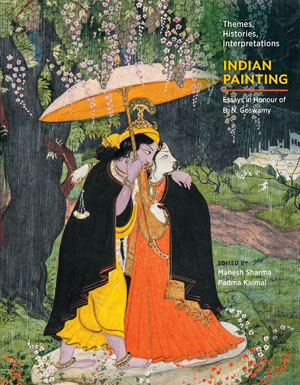|
|
The South
Asian Life & Times - SALT |
|
|||
|
Contents Adventure
Art
-
Dongria Kondh
|
|
||||
|
Indian Painting
This volume is a collection of essays – a tribute
by the academia to the distinguished art historian B N Goswamy on the
occasion of his 80th
birthday. The essays celebrate the diversity of South Asia’s art traditions
and histories. There is a vast chronological span and range of the essays –
Redecoration of Ajanta Cave 10 by Walter Spink, The Marvellous Tree of
Multan by Tryna Lyons, The Secular Sikh Maharaja and his Muslim Wife: Rani
Gul Bahar Begum by Nadhra Shahbaz Khan, Visualising the Ramayana by Gulam
Mohammed Sheikh, Deogarh Thikana Paintings by Usha Bhatia, illustrate the
diversity of content. Susan Stronge, Devangana Desai, Amit Ambalal are among
the forty renowned scholars and critics who have contributed to this
remarkable publication. Padma Kamal and F S Aijazuddin have recollected
their fond impressions of Mr Goswamy.
Contributors have explored religious and
mythological themes, as also many forms of paintings such as murals of
Taunsa (Multan) and Shekhawati (Rajasthan), and narrative paintings from
Kerala – all with interesting and scholarly revelations. Mary Heston, in her
essay “Iconicity” on Transformation in Kerala Narrative Painting writes:
“Rama’s story at Mattancheri is delineated in a series of seven painted
compositions … corresponding roughly to the seven kandas of Valmiki’s epic.”
One of the most consistent features of these paintings is the depiction of
faces in three-quarter view. The profile is rare in Kerala, and the frontal
view was generally reserved for depicting deities in iconic form.”
Similarly, Tryna Lyons, in her article ‘The
Marvellous Tree of Multan,’ writes of
Hamagul
– a painting of “a marvellous tree, bearing upon its branches every manner
of flower, fruit and vegetable “ executed by painters of Multan. “These
traditional painters still dwell in Mohallah Kamaangran, inside the old
walled city, where they have long been known as the ‘bowmakers’ (kamaangar).
The inner chambers of important buildings often “feature walls covered with
paintings of vines, cypresses, and flowers. Amidst the profusion of plant
life, one botanical image predominates – artists of Multan call it
hamagul.” It is perhaps one of the finest books on Indian Art
– a sheer delight and certainly a collector’s item.
|
|||||
|
Copyright © 2000 - 2014 [the-south-asian.com]. Intellectual Property. All rights reserved. |
|||||
